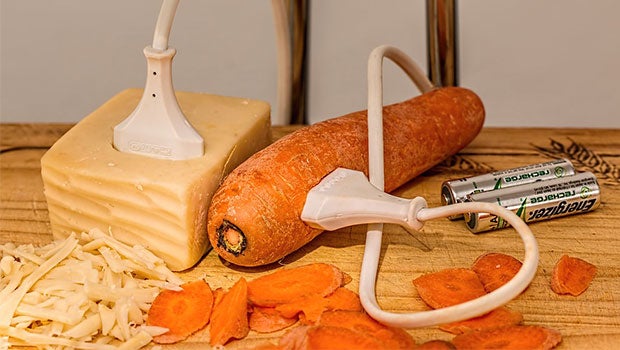
By Alvin Chumari
That unfinished two spoonfuls of rice from lunch. The packet of kangkong that was bought but tucked away in the fridge and forgotten till it turned yellow. We hardly take notice of such food waste that we chuck into dustbins on a daily basis. But if you’re operating a hospital central kitchen like CGH, which generates close to 725kg of food waste daily – that’s equivalent to the weight of 145 packets of 5kg rice - you can’t treat food waste in the same nonchalant manner.
Typical food waste produced by the CGH hospital kitchen mainly includes trimmings from food preparation such as vegetables, fruits, meat as well as left over meals from the wards. Previously, they were disposed of in the conventional way – two staff would manually carry and throw the food waste into the general waste compactor bin. Apart from being physically laborious (especially for elderly housekeeping staff), the food waste resulted in odours and vermin infestations at times, as the waste compactor is cleared only once a day.
However, as of August last year, the ‘ecoDigester’ food recycling system was introduced at CGH. It looks like a typical waste container you find in the HDB bin centre but with an inlet funnel at the top for “feeding” the recyclable food waste. In the digester, special enzymes and water are added to help accelerate food decomposition within 24 hours. This turns the food waste into non-drinkable water that can either be reused by the machine or used for general floor cleaning. In fact, the amount of water produced from food waste recycling is almost 1:1. This means that 725kg of food waste produces almost 720 litres of water. Only 2-3% (around 21kg) of food sludge remains and is disposed of as normal waste.
The ‘ecoDigester’ at Work!
Step 1: .jpg) Food waste that is safe for recycling is first sorted by Dietetic & Food Services (DFS) staff and placed into easily-identifiable red recycling bins. For non-recyclable food waste such as utensils, big chunks of food and excessive liquids (such as porridge and gravy), these are dumped into conventional green bins for disposal.
Food waste that is safe for recycling is first sorted by Dietetic & Food Services (DFS) staff and placed into easily-identifiable red recycling bins. For non-recyclable food waste such as utensils, big chunks of food and excessive liquids (such as porridge and gravy), these are dumped into conventional green bins for disposal.
Step 2: .jpg)
.jpg)
A housekeeper transports the recycling bins to the ‘ecoDigester’ and onto the auto-lifter.
Step 3:
.jpg)
.jpg)
With just the push of a button, the recycling bin is lifted and the food waste is dropped directly into the ‘ecoDigester’. Twenty-four hours later, the food waste becomes water. That’s it, so simple!
Going green can work!
Introducing environmentally-friendly initiatives in the workplace can work if it’s easy to adopt and lightens/simplifies the work of the staff. So kudos to the CGH team for doing this successfully!
 The team (from left to right):
The team (from left to right):
Mr Cheng Khim Seng (Environmental Services), Mr Voon Nyuk Fond (ISS Housekeeping Supervisor), Mr Vince Goh (Dietetic & Food Services), Mr Ting Sai Chuen (ISS Housekeeper), Ms Tenny Chow (Support Services), Ms Rafedah (Dietetic & Food Services) and Ms Wendy Neo (Dietetic & Food Services)
Keen to start reducing food waste at home?
Here are simple ways how:
- Check what’s in your fridge before you go grocery shopping. And avoid grocery shopping on an empty stomach – you tend to buy more than what you actually need!
- Declutter your fridge – keep your groceries neat and visible; and move items that were stored for a longer time to the front so that you would consume it first.
- Store your food correctly so they last longer.
- Make leftovers your next meal; there are many recipes online for cooking with leftovers.
- Know your expiry labels – food beyond the ‘best before’ are usually still safe to eat!













 Get it on Google Play
Get it on Google Play